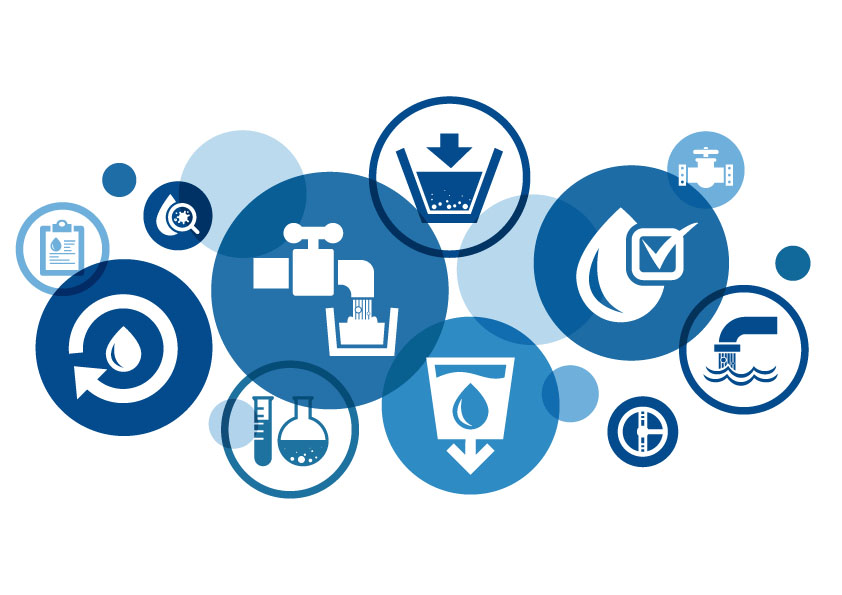Committed to quality water
We focus every day on ensuring the safety of federal employees, contractors, and visitors in federal buildings. That includes maintaining water quality in our facilities, which is pivotal for a healthy work environment. Consulting with federal, state and local governments and industry experts, We developed a new Order and Desk Guide for Drinking Water Quality Management (PBS 1000.7A). This new guidance serves as a cornerstone in maintaining drinking water standards for federally owned facilities and leased space under the jurisdiction, custody or GSA-controlled. As part of GSA’s new water quality management plan, it is implementing a scope of sampling and testing that is above established regulations. Our goal is to proactively identify issues and adjust water management practices to prevent and, if necessary, correct any potential areas of concern.
PBS’ water quality management strategy
PBS water quality management will:
- Establish baseline drinking-water quality tests at approximately 1,400 federally owned facilities and approximately 6,000 leased spaces in Fiscal Year (FY)24.
- Test federally owned facilities that are over 1,000 Square Feet (SF) with drinking water systems and GSA-controlled leased spaces that do not expire in FY24.
- Develop and implement water sampling and flushing plans based on ASHRAE recommendations in approximately 350 federally owned facilities that are higher than six stories and over 50,000 SF with one or more water booster pumps.
- Perform weekly water flushing in areas of buildings with childcare centers, healthcare units, and showers, regardless of the building size.
- Perform monthly Legionella testing of all cooling towers, humidifiers, and decorative fountains (during the operating season).
Implementation and testing schedule
- Drinking water at all applicable GSA-controlled spaces will be tested in FY24.
- Water testing at specific building locations will be communicated by GSA at the local level.
What to expect when testing occurs
- The Operations and Maintenance contractor or Lessor, when appropriate, will notify GSA within 24 hours of receiving laboratory results that exceed threshold levels. GSA will not receive final reports until approximately 30 days after testing.
- When results are received that indicate that EPA, or relevant state or local thresholds have been exceeded for lead, copper, total coliform bacteria, or E.coli, or when growth is not well controlled for Legionella, the controlling authority of the facility (e.g., GSA, a delegated agency, or a lessor) will:
- Notify occupants of results and post relevant signage.
- Remove impacted outlets from service.
- Begin remediation, such as flushing the system and adjusting operational parameters (e.g., water temp). If not effective, additional corrective actions such as hyperchlorination or similar measures will be investigated.
- During corrective actions, temporary measures such as providing bottled water can be used to ensure safe alternatives for water use if adequate potable water is temporarily unavailable.
- Retest facilities to ensure corrective actions have been effective.
- Notify occupants of follow-up testing results.
- Continue with additional corrective actions and testing if deemed necessary.
FAQs
How is the Legionella bacteria spread?
Legionella bacteria naturally exists in freshwater but can become a concern in building water systems when water contaminating Legionella becomes aerosolized. It is not generally transmitted through person-to-person contact or by consuming water. For more information about Legionella and other water-borne bacteria, visit the Centers for Disease Control’s Water Contamination and Diseases website.
Why is GSA testing for Legionella in federal buildings?
GSA is taking actions based on recently updated voluntary standards and advice from subject matter experts, as well as that of industry groups like the American Industrial Hygiene Association (AIHA).
Are buildings with elevated levels of Legionella safe?
If Legionella is not well controlled in a building’s water system, GSA implements industry standard recommendations for any corrective actions needed while reducing risk and helping to ensure that our occupants are safe.
What preventative measures is GSA taking to reduce the risk of Legionella?
GSA is proactively implementing a wide variety of water management practices. Our goal is to identify issues and adjust water management practices to help ensure Legionella remains well controlled.
What steps is GSA taking to keep occupants safe?
If test results indicate that EPA, or applicable relevant state or local thresholds have been exceeded for lead, copper, total coliform bacteria, or E.coli, or when growth is not well controlled for Legionella, GSA takes immediate actions based on federal expert resources as well as that of industry groups like the AIHA.
What do I do if I suspect I’ve been affected by Legionella?
Talk to your healthcare provider. Also, here is a link to the CDC Fact Sheet on Legionnaires’ Disease.


 U.S. General Services Administration
U.S. General Services Administration